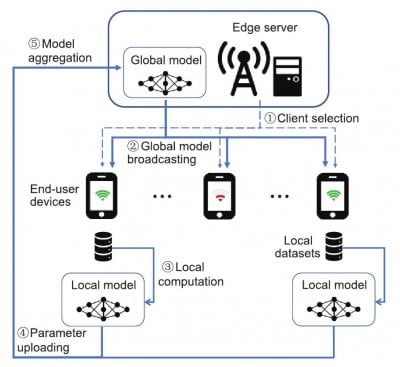Newswise — A study led by researchers from the National University of Defense Technology published a review paper in Frontiers of Information Technology & Electronic Engineering (FITEE), in the special topic “Computing-Communication Integration: Architectures, Theories, and Practices”. The paper provides a comprehensive survey and analysis of the latest advances in energy-efficient strategies for federated learning (FL) in mobile edge computing (MEC).
The paper details the basic architecture of the FL system. The FL system in MEC includes an edge server and end-user devices (EDs), as well as global and local models. It also presents computation and communication energy consumption models. The computation energy consumption model is divided into two types: central processing unit (CPU) and graphics processing unit (GPU), while the communication energy consumption model covers three transmission schemes: time division multiple access (TDMA), frequency division multiple access (FDMA), and non-orthogonal multiple access (NOMA).
FL faces several challenges in improving energy efficiency. First, the heterogeneity in computing and communication capabilities among EDs leads to variations in energy consumption and performance, causing the straggler problem. Second, data heterogeneity, especially non-IID data, leads to inconsistency with the global optimal solution, requiring more training rounds and thus increasing energy consumption. Third, the execution environment with co-running applications and highly dynamic network connections increases the variability in energy efficiency. Additionally, the increasing complexity of machine learning models brings energy-intensive local computations and communication loads. To address these challenges, existing works focus on optimizing energy efficiency in FL from two perspectives: distributed learning and system design. The former attempts to employ learning-based strategies to increase the convergence rate of FL and enhance energy efficiency, while the latter focuses on developing resource allocation and client selection strategies for energy-efficient FL.
Learning-based strategies include model compression, hyperparameter optimization, and training algorithm improvement, aiming to improve training efficiency and reduce energy consumption. However, each has its advantages and disadvantages. For example, model compression needs to balance compression and accuracy, hyperparameter optimization should consider device heterogeneity, and training algorithm improvement introduces additional computation overhead.
Resource allocation-based strategies are divided into computation resource allocation, communication resource allocation, and joint computation-and-communication (C2) resource allocation strategies, mainly focusing on optimizing CPU frequency, bandwidth allocation, transmission power, and other computing and communication resources to improve energy efficiency. However, there are still issues such as poor adaptation to dynamic energy consumption requirements in real-world environments, risks of privacy breaches and security vulnerabilities, and lack of practical validation and research.
Client selection strategies are divided into direct and indirect energy-efficient client selection strategies. Direct strategies focus on selecting devices with better performance based on system heterogeneity to directly reduce energy consumption. Indirect strategies consider data heterogeneity and select devices more conducive to improving model accuracy, thus accelerating model convergence and indirectly reducing energy consumption. However, existing strategies have problems such as selection bias, ignoring device runtime behavior, and the impact of client combinations on FL performance.
The paper also introduces the latest technologies to address FL energy consumption challenges, including the application of simultaneous wireless information and power transfer (SWIPT), wireless power transfer (WPT), intelligent reflecting surface (IRS), and device-to-device (D2D) communication in FL. The introduction of these new technologies is expected to solve the problem of low device battery capacity and improve the energy efficiency of FL, but there are also limitations such as low energy transfer efficiency, high system cost and complexity, and impact of device mobility.
Finally, three potential key directions for achieving energy-efficient FL in the future are discussed: leveraging hardware advancements, advancements in communication technologies, and integration of state-of-the-art AI methods. By considering these aspects, researchers and practitioners can build more energy-efficient and advanced FL systems.
The paper “A survey of energy-efficient strategies for federated learning in mobile edge computing” authored by Kang YAN, Nina SHU, Tao WU, Chunsheng LIU and Panlong YANG. Full text of the open access paper: https://doi.org/10.1631/FITEE.2300181.
